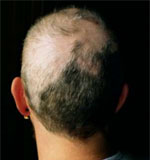Hi Doc! I’ve just about made it through all 800+ pages on the Balding Blog and have a couple of questions about scalp reductions. I know you and most hair restoration physicians discredit them, but are there ever cases where one could be performed? Assuming good scalp laxity, how much could be removed without causing the slot deformity in the back? Some physicians still list some form of scalp reduction on their site and I’m wondering what they do these days that won’t cause more problems later.

 Scalp reductions are not the “gold standard” in treating male pattern hair loss, because the results are sub-optimal and you end up with a scar along the top of your scalp that will be visible with continued hair loss. Although I hate to use the term “never”, I will say that I can not imagine using scalp reductions on any patient today.
Scalp reductions are not the “gold standard” in treating male pattern hair loss, because the results are sub-optimal and you end up with a scar along the top of your scalp that will be visible with continued hair loss. Although I hate to use the term “never”, I will say that I can not imagine using scalp reductions on any patient today.
Now with that said, a few of the old timers that have judgments and experience with follicular unit transplantation may find an indication for performing a scalp reduction and it might be reasonable in their hands to do a few. If the scalp reduction is limited to no more than 1-2 surgeries, then the probability of a slot deformity would be minimal and the thinning of the scalp will also be minimized. Reductions also tend to lose their value over time (a term called stretch-back) and the patient would need to understand that risk.
I had 3 scalp reductions in 1992-1993 and my scalp became very thin and easily damaged by sun. I also had a full stretch-back, resulting in a return to the original balding pattern from before the first surgery. The medical-legal risk of scalp reductions to the doctor is not insignificant in today’s litigious society, so few doctors will face the legal risk with complications that were so frequent in the early days. In the 1980s, doctors would do these frequently because the money was good ($2,000-2,500 per procedure) and the skilled doctor would be able to do it in 15-20 minutes. So the attraction to do something so profitable was irresistible for many doctors, bringing out the larcenous side of those who had that tendency. Add to that the need for 3-6 surgeries in most people and that made the money look better and better for the doctor, so much so that they lost their sense of compassion for the patients who had the many, many complications of this procedure.
For more information, including the history of scalp reductions and photos, see here.

 I belong to an email group of hair transplant physicians who communicate regularly to share information. Most recently, the group was polled to determine the side effects that these doctors see with finasteride.
I belong to an email group of hair transplant physicians who communicate regularly to share information. Most recently, the group was polled to determine the side effects that these doctors see with finasteride.
 I do not believe 11 weeks in and of itself should have a detrimental effect on your hair loss issue.
I do not believe 11 weeks in and of itself should have a detrimental effect on your hair loss issue. I am going to assume you do not look bald at Norwood 2. You are very worried about some thinning in the front. The doctor you saw is likely a general internist who does not see hair loss patients as his primary practice. And even if that doctor is the most caring and sympathetic doctor in the world, if he does not treat patients with hair loss on a day-to-day basis as his number one priority, they would most likely not pay attention to young men who do not look bald. I do not think it is the doctor’s fault, but it is just the way doctors are trained. You see, hair loss is not considered an illness or a disease. It does not affect your health. So doctors really do not learn about it and its treatment in medical school.
I am going to assume you do not look bald at Norwood 2. You are very worried about some thinning in the front. The doctor you saw is likely a general internist who does not see hair loss patients as his primary practice. And even if that doctor is the most caring and sympathetic doctor in the world, if he does not treat patients with hair loss on a day-to-day basis as his number one priority, they would most likely not pay attention to young men who do not look bald. I do not think it is the doctor’s fault, but it is just the way doctors are trained. You see, hair loss is not considered an illness or a disease. It does not affect your health. So doctors really do not learn about it and its treatment in medical school. Matt Kelley was 38 when he first noticed a round, hairless spot in his beard. Within six weeks, every inch of his body that once had hair — including his eyebrows, eyelashes, arms and head — was completely bald.
Matt Kelley was 38 when he first noticed a round, hairless spot in his beard. Within six weeks, every inch of his body that once had hair — including his eyebrows, eyelashes, arms and head — was completely bald.  The density has nothing to do with the harvesting method used, just the number of hairs per square mm that the grafts are placed in. Generally, depending upon hair/skin color and hair texture, the amount of hair needed to look full will reflect somewhere between 25-50% of your original density. One reason follicular unit extraction (FUE) might be best used for smaller cases has more to do with costs involved, since it is the more expensive procedure.
The density has nothing to do with the harvesting method used, just the number of hairs per square mm that the grafts are placed in. Generally, depending upon hair/skin color and hair texture, the amount of hair needed to look full will reflect somewhere between 25-50% of your original density. One reason follicular unit extraction (FUE) might be best used for smaller cases has more to do with costs involved, since it is the more expensive procedure.